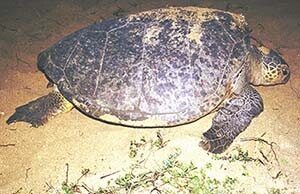Light pollu

Artificial lights within the human-built environment can lead females to nest in less suitable sites, decreasing the success of the clutches laid into the nest. Hatchlings are directly affected too, by becoming either misoriented (moving more inland, rather than toward the ocean) or disoriented (crawling in circuitous paths). The results can be fatal. Mis- or disoriented hatchlings often become exhausted, dehydrated, and more exposed to predators, not to mention to vehicular kills.

It is important to develop the most effective management strategies to protect sea turtles. Before the development and widespread adoption of geospatial technologies and spatial analysis techniques, conservation policies depended on expensive, large-scale surveys involving many people conducting field visits to beach habitats.
Survey data were used to inform the creation of appropriate zoning and light ordinances. Geospatial data, such as satellite-derived imagery, have made understanding the geographic distribution, intensity, and ecological impacts of artificial light less expensive and easier to analyze.
by Wan-Hwa Cheng